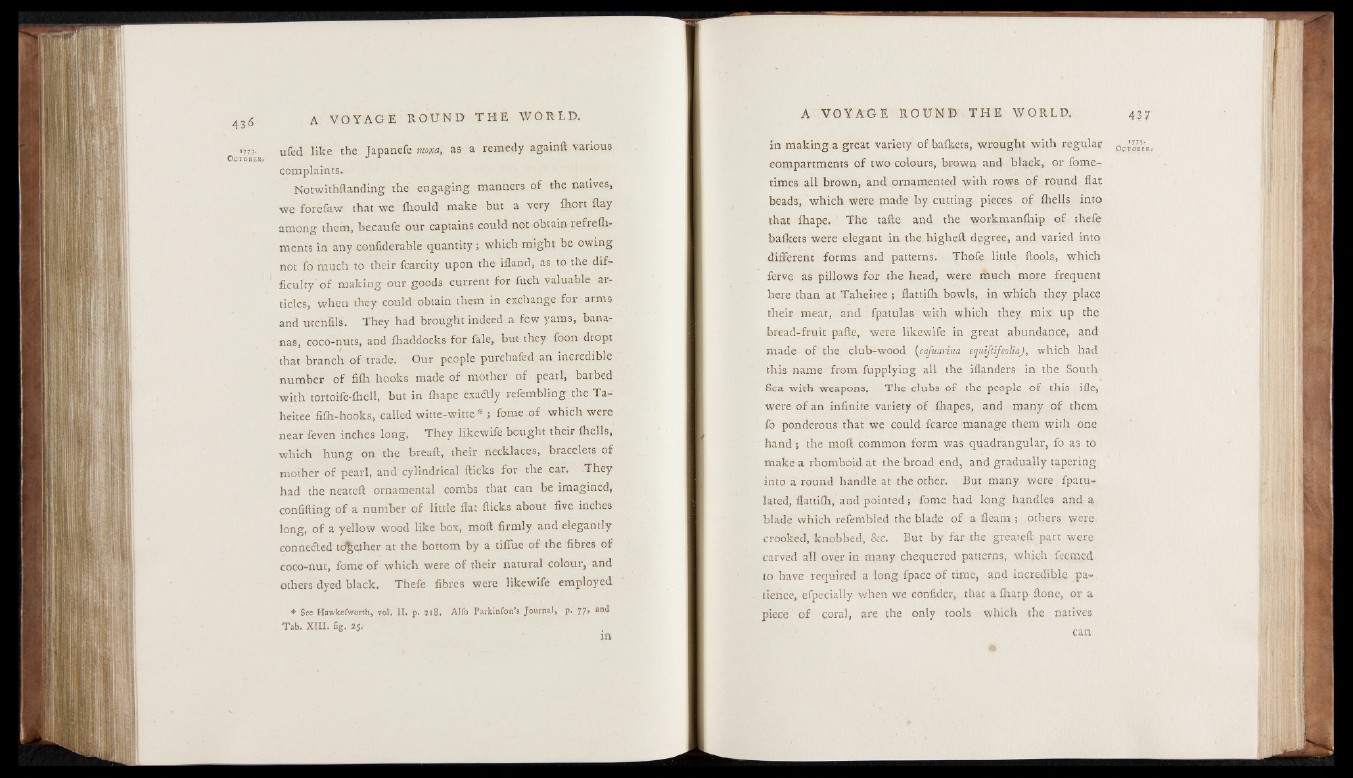
*773-
O c t o b e r .
ufed like the Japanefe m m as a remedy againfl various
complaints.
Notwithftanding the engaging manners of the natives,
we forefaw that we fhould make but a very fhort flay
among them, becaufe our captains could not obtain refrefh-
ments in any confiderable quantity ; which might be owing
not fo much to their fcarcity upon the ifland, as to the difficulty
of making our goods current for fuch valuable articles,
when they could obtain them in exchange for arms
and utenfils. They had brought indeed a few yams, bananas,
coco-nuts, and fhaddocks for fale, but they foon dropt
that branch of trade. Our people purchafed an incredible
number of fifh hooks made of mother of pearl, barbed
with tortoife-fhell, but in fhape exadtly refembling the Ta-
heitee fifli-hooks, called witte-witte* ; Lome of which were
near feven inches long. They likewife bought their fhells,
which hung on the bread:, their necklaces, bracelets of
mother of pearl, and cylindrical flicks for the ear. They
had the neateft ornamental combs that can be imagined,
confiding of a number of little flat flicks about five inches
long, of a yellow wood like box, moll firmly and elegantly
connected together at the bottom by a tifiue of the fibres of
coco-nut, fome of which were of their natural colour, and
others dyed black. Thefe fibres were likewife employed
* See Hawkefworth, vol. II. p. 2 1 8 . Alfo Parkinfon’s Journal, p. 77» an^
Tab. XIII. fig. »Sin
4 3 7
in making a great variety of bafkets, wrought with regular October
compartments of two colours, brown and black, or fome-
times all brown, and ornamented with rows of round flat
beads, which were made by cutting pieces of fhells into
that fhape. The talle and the workmanfhip of thefe
bafkets were elegant in the highefl degree, and varied into
different forms and patterns. Thofe little floods, which
ferve as pillows for the head, were much more frequent
here than at Taheitee ; flattifh bowls, in which they place
their meat, and fpatulas with which they mix up the
bread-fruit pafte, were likewife in great abundance, and
made of the club-wood [cafuarina equiftifeolia), which had
this name from fupplying all the iflanders in the South
Sea with weapons. The clubs of the people of this ifle,
were of an infinite variety of fliapes, and many of them
fo ponderous that we could fcarce manage them with one
hand ; the mod common form was quadrangular, fo as to
make a rhomboid at the broad end, and gradually tapering
into a round handle at the other. But many were fpatti-
lated, flattifh, and pointed; fome had long handles and a
blade which refembled the blade of a fleam j others were
crooked, knobbed, &c. But by far the greateft part were
carved all over in many chequered patterns, which feemed
to have required a long fpace of time, and incredible patience,
efpecially when we confider, that a fharp ftone, or a
piece of coral, are the only tools which the natives
can